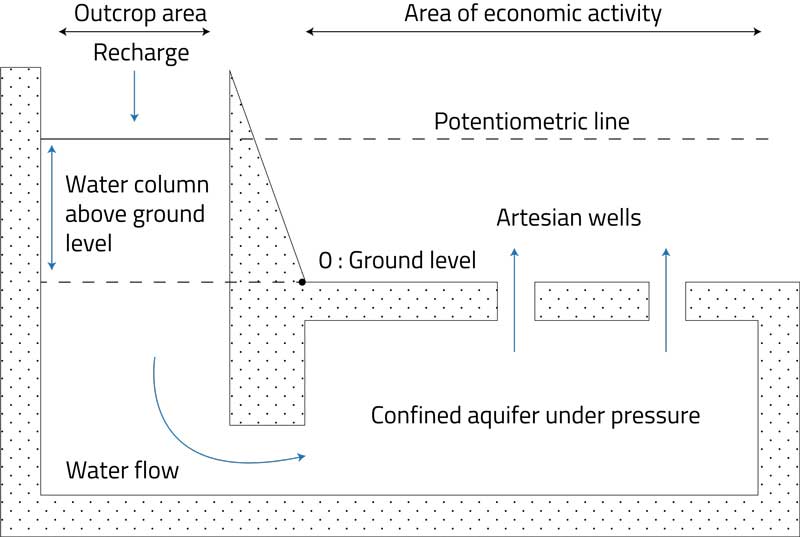Hubert Stahn & Agnes Tomini, 2021, Journal of Environmental Economics and management, 109
RESEARCH PROGRAM
The literature on common-pool resources has tended to examine all the externalities due to the two characteristics of common goods: non-excludability and rivalry. In particular, the literature on aquifers has focused on the external cost of stock reduction. But what if the aquifer never empties? This is especially likely with confined aquifers, where withdrawals are immediately replaced. Does this resource escape the “Tragedy of commons”? What makes such analysis even more important is the current debate over the need to implement water regulation. Many studies have argued that there may be no difference between the water table level under a "laissez-faire" scenario and the level under socially-optimal management in the long run. Welfare gains from regulation will consequently be negligible. This result is now known as the Gisser-Sanchez effect.
Confined aquifers have two properties. They are confined between an upper and a lower impermeable layer. Water naturally flows from a well, without any pumping, even above the land surface when the aquifer is artesian, but this water is simultaneously replaced by gravity discharge. Artesian aquifers can be found in many countries: The Great Artesian Basin (Australia), the Edwards Aquifer (Texas, USA) and the Northern Sahara Aquifer System in northern Africa are major systems providing water for millions of people.
PAPER’S CONTRIBUTIONS
The main objective of our study is to understand how artesian aquifers may be over-exploited. Modeling such natural resources is our first contribution. We use the fluid mechanism to characterize the hydrodynamics of the aquifer and the interdependencies between water abstraction, recharge, and variations in water pressure. The water pressure of the whole aquifer actually rises with water coming from a distant recharge area and falls with exploitation. Contrary to the standard approach considering unconfined aquifers, we do not look for the optimal amount of water to extract. Instead, we choose the number of wells. We can do this because we know the maximum amount of water flowing out of a well, which depends on the water pressure and the well’s technical characteristics (e.g. diameter of the well).
We then characterize exploitation under an openaccess regime and contrast this situation with the socially-optimal equilibrium. We show that private users ignore their impact on overall water pressure, which leads to a greater number of wells in the long run for the same water consumption in both management regimes. Economic agents therefore do not compete to appropriate part of the resource stock, but suffer from a reduction in artesian pressure as the number of wells increases. The extra decline in pressure that arises under open-access is what we refer to as the pressure externality. We introduce two measures to assess the impact of this externality: i) the yield reduction rate to depict the hydrological consequences and ii) the rate of increase in water cost to assess the economic consequences. Importantly, we show that the Gisser-Sanchez effect does not apply here, since welfare gains from optimal management depend on the size of the recharge area, not on the size of the aquifer.
We finally provide a state-dependent tax scheme that corrects this externality at the steady state.
RESEARCH PROCESS
This study was inspired by discussions with hydrologists from CEREGE on the Northern Sahara Aquifer System in northern Africa. It emerged that the vast majority of studies on groundwater economics assume unconfined aquifers that are depleted with exploitation, ignoring the other types of aquifers. This turned our attention to the question of the depletion of artesian aquifers. The main difficulty lay in correctly characterizing such aquifers.
FUTURE RESEARCH
We use a very simple setting to isolate the pressure externality, only considering the two polar management regimes, without addressing strategic externality. We also introduce a schematic characterization of the aquifer, although more complex dynamics are observed in the real world (e.g. endogenous infiltration rate, leakages or multicell system). Finally, we exclusively look at situations where artesian properties are held long-term. It could be interesting to analyze situations in which these properties disappear, that is, when an artesian aquifer becomes an unconfined aquifer in the long run and pumping is required.

Schematic representation of an artesian aquifer under exploitation
→ This article was issued in AMSE Newletter, Winter 2021.






